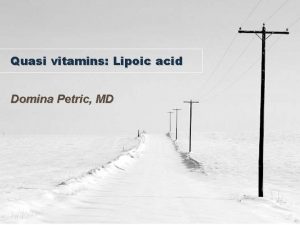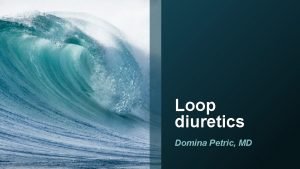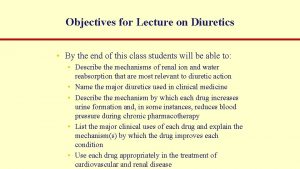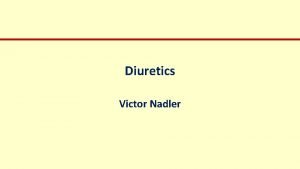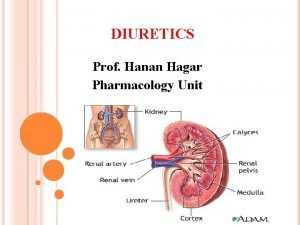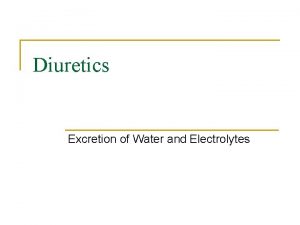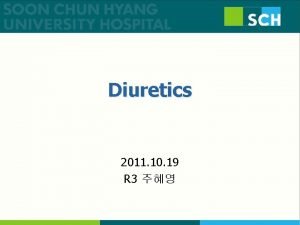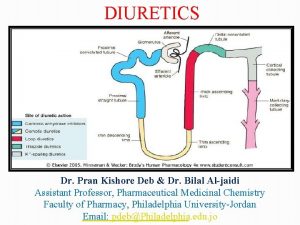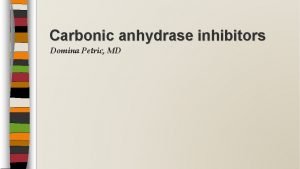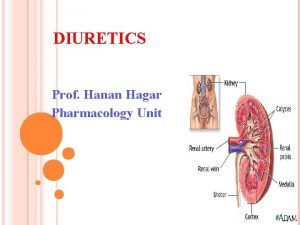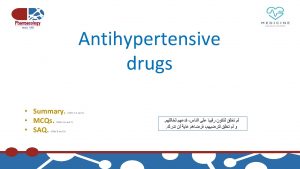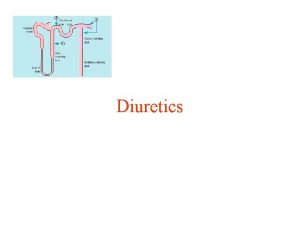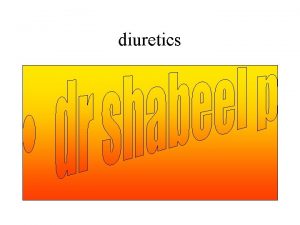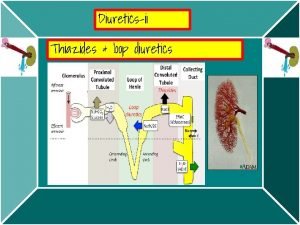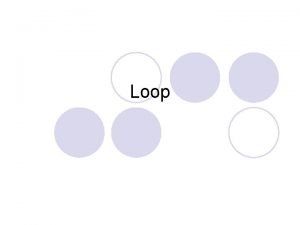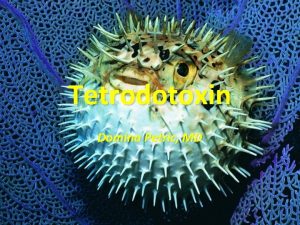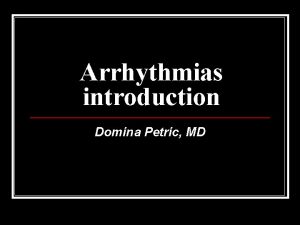Loop diuretics Domina Petric MD Introduction Loop diuretics
























- Slides: 24

Loop diuretics Domina Petric, MD

Introduction Loop diuretics selectively inhibit Na. Cl reabsorption in the thick ascending limb of Henle´s loop (TAL). TAL has large Na. Cl absorptive capacity. Diuretic action of loop diuretics is not limited by development of acidosis. These drugs are the most efficacious diuretic agents currently available.

Chemistry • Furosemide, ethacrynic acid! • Bumetanide and torsemide are sulfonamide loop diuretics. • Ethacrynic acid is a phenoxyacetic acid derivative containing an adjecent ketone and methylene group. • The methylene group forms an adduct with the free sulfhydryl group of cysteine. • The cysteine adduct appears to be an active form of the drug. • Organic mercurial diuretics also inhibit salt transport in the TAL, but are toxic.

Pharmacokinetics • The loop diuretics are rapidly absorbed. • They are eliminated by the kidney by glomerular filtration and tubular secretion. • Absorption of oral torsemide is 1 hour and that of furosemide 2 -3 hours. • Oral absorption is nearly as complete as with intravenous administration. • The duration of effect for furosemide is 2 -3 hours and of torsemide 4 -6 hours.

Pharmacokinetics • Half-life depends on renal function. • Loop agents act on the luminal side of the tubule. • Their diuretic activity correlates with their secretion by the proximal tubule. • NSAIDs and probenecid compete for weak acid secretion in the proximal tubule. • Simultaneous administration of loop diuretics and NSAIDs result in reduction in the secretion of loop diuretics.

Pharmacodynamics • Loop diuretics inhibit the luminal Na+/K+/2 Cltransporter (NKCC 2) in the TAL of Henle´s loop. • These agents reduce the reabsorption of Na. Cl and diminish the lumen-positive potential that comes from K+ recycling. • Loop diuretics cause an increase in Mg 2+ and Ca 2+ excretion. • Prolonged use can cause significant hypomagnesemia.

Pharmacodynamics • Loop diuretics do not generally cause hypocalcemia because vitamin D-induced intestinal absorption and parathyroid hormone-induced renal reabsorption of Ca 2+ can be increased. • In disorders that cause hypercalcemia, Ca 2+ excretion can be enhanced by treatment with loop diuretics combined with saline infusions. • Loop diuretics induce expression of cyclooxygenase 2 (COX-2) which participates in the synthesis of prostaglandins from arachidonic acid.

Pharmacodynamics • PGE 2 inhibits salt transport in the TAL and participates in the renal actions of loop diuretics. • NSAIDs can interfere with the actions of loop diuretics by reducing prostaglandin synthesis in the kidney. • This interference is significant in patients with nephrotic syndrome or hepatic cirrhosis. • Furosemide increases renal blood flow via prostaglandin actions on kidney vasculature. • Furosemide and ethacrynic acid reduce pulmonary congestion and left ventricular filling pressures in heart failure.

Typical dosages of loop diuretics Drug Bumetanide Ethacrynic acid Furosemide Torsemide Total daily oral dose 0, 5 -2 mg 50 -200 mg 20 -80 mg 5 -20 mg

Clinical indications The most important are ACUTE PULMONARY EDEMA, OTHER EDEMATOUS CONDITIONS AND ACUTE HYPERCALCEMIA. Other indications are hyperkalemia, acute renal failure and anion overdose.

Edematous states • Reduction of peripheral or pulmonary edema that has accumulated as a result of cardiac, renal or vascular disease, that reduce blood flow to the kidney. • This reduction is sensed as insufficient effective arterial blood volume, which leads to salt and water retention. • Excessive diuretic therapy may compromise the effective arterial blood volume and reduce the perfusion of vital organs. • The use of diuretics to mobilize edema requires careful monitoring of the patient´s hemodynamic status.

Hyperkalemia Loop diuretics can significantly enhance urinary excretion of potassium. This response is enhanced by simultaneous Na. Cl and water administration.

Acute renal failure • Loop agents can increase the rate of urine flow and enhance potassium excretion in acute renal failure. • They can not prevent or shorten the duration of renal failure. • If a large pigment load has precipitated acute renal failure, loop agents may help to flush out intratubular casts and ameliorate intratubular obstruction. • Loop agents can worsen cast formation in myeloma and light chain nephropathy: increased distal Cl- concentration enhances secretion of Tamm-Horsfall protein. • This protein aggregates with myeloma Bence Jones proteins.

Anion overdose Loop diuretics are useful in treating toxic ingestions of bromide, fluoride and iodide, which are reabsorbed in the TAL. Saline solution must be administered to replace urinary losses of Na+ and to provide Cl-. This is important to avoid extracellular fluid volume depletion.

Toxicity Hypokalemic metabolic alkalosis Ototoxicity Hyperuricemia Hypomagnesemia Allergic and other reactions

Hypokalemic metabolic alkalosis • By inhibiting salt reabsorption in the TAL, loop diuretics increase sodium delivery to the collecting duct. • Increased delivery leads to increased secretion of potassium and hydrogen ions by the duct: hypokalemic metabolic alkalosis. • This toxicity is a function of the magnitude of the diuresis and can be reversed by potassium replacement and correction of hypovolemia.

Ototoxicity Dose-related hearing loss is usually reversible. It is most common in patients who have diminished renal function or who are receiving simultaneously other ototoxic agents (for example, aminoglycoside antibiotics).

Hyperuricemia Loop diuretics can cause hyperuricemia and precipitate attacks of gout. This is caused by hypovolemia-associated enhancement of uric acid reabsorption in the proximal tubule. It may be prevented by using lower doses to avoid development of hypovolemia.

Hypomagnesemia Magnesium depletion is a consequence of the chronic use of loop agents. It occurs most often in patients with dietary magnesium deficiency. It can be reversed by administration of oral magnesium preparations.

Allergic and other reactions All loop diuretics, except ethacrynic acid, are sulfonamides: • • • skin rash eosinophilia interstitial nephritis This toxicity usually resolves rapidly after drug withdrawal. Allergic reactions are much less common with ethacrynic acid.

Allergic and other reactions • Henle´s loop is indirectly responsible for water reabsorption by the downstream collecting duct. • Loop diuretics can cause severe dehydration. • Hyponatremia is less common than with the thiazides. • Patients who increase water intake in response to hypovolemia-induced thirst can become severly hyponatremic. • Loop agents can cause hypercalciuria, which can lead to mild hypocalcemia and secondary hyperparathyroidism.

Allergic and other reactions Loop agents can have the opposite effect, hypercalcemia, in volume-depleted patients who have another cause for hypercalcemia: metastatic breast or squamous cell lung carcinoma.

Contraindications Furosemide, bumetanide and torsemide may exhibit allergic cross-reactivity in patients sensitive to other sulfonamides, but it is very rare. Overzealous use of any diuretic is dangerous in hepatic cirrhosis, borderline renal failure and heart failure.

Literature • Katzung, Masters, Trevor. Basic and clinical pharmacology.
 Domina petric
Domina petric Domina petric
Domina petric Domina severe
Domina severe Domina petric
Domina petric Domina petric
Domina petric Domina petric
Domina petric Domina petric
Domina petric Loop diuretics adverse effects
Loop diuretics adverse effects Acidifiers and alkalinizers
Acidifiers and alkalinizers Furosemide side effects
Furosemide side effects Diuretics classification
Diuretics classification Diuretics classification
Diuretics classification Loop diuretics
Loop diuretics Chlorothiazide synthesis
Chlorothiazide synthesis Jure petric
Jure petric Najljepši stihovi o hrvatskom jeziku
Najljepši stihovi o hrvatskom jeziku 8 atitudes vencedoras a ponte
8 atitudes vencedoras a ponte Domina los aprendizajes requeridos
Domina los aprendizajes requeridos Cada miembro domina una parcela determinada del proyecto.
Cada miembro domina una parcela determinada del proyecto. Carbonic anhydrase use
Carbonic anhydrase use Kitzler witze
Kitzler witze Domina epistulam
Domina epistulam Diuretic side effects
Diuretic side effects Hyperuricemia classification
Hyperuricemia classification Diuretics classification
Diuretics classification
